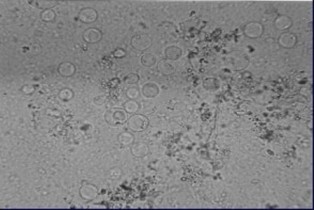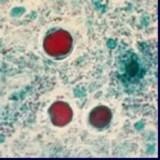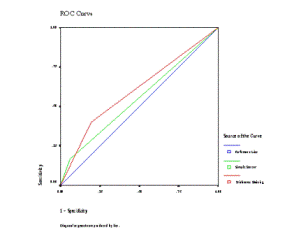|
Routine diagnosis is usually performed by a simple smear in normal saline or
iodine solution. Several forms of B. hominis can be found in stool
specimens, i.e. vacuolar, multivacuolar, avacuolar, granular, ameboid and cyst.
However, most laboratories recognize only the vacuolar form as the diagnostic
stage since it can be easily distinguished from other protozoa. As the result,
the prevalence determined by wet mount preparation may be underreported.
In vitro cultivation methods have been used to enhance detection; however,
the usefulness of these methods is still controversial. Currently, some
researches have shown that in-vitro cultivation is more sensitive and specific
in detection of B. hominis than the simple smear and concentration
technique because it increases the size and number of the organism.

This picture shows B. hominis that are multiplied and enlarged by
in-vitro cultivation. Only one form of B. hominis is seen after
cultivation which is called vacuolar form.
The trichrome staining is routine diagnostic method for detection of B.
hominis. Even though it increases sensitivity from a simple smear, it is
limited due to the difficulty of identification because of parasites' variation
in form and size, variation in staining, the need of professional technician and
complicated steps of staining.

This pictures show morphology of B. hominis from trichrome staining
under LM. It has one large central vacuole with trichrome staining filled in
it, and 2 to 4 stained peripheral nuclei. The size varies between 2 to 200 um
in diameter.

The detection of Blastocystis hominis in stool specimens by simple smears
and trichrome staining compared to in vitro cultivation
This table shows detection of B. hominis in stool specimens by simple
smear and trichrome staining compared with in-vitro cultivation. 102 of the
samples were found to be culture positive.
The sensitivity and specificity of simple smear are 16.7% and 94%, while the
sensitivity and specificity of trichrome staining are 40.2% and 80.4%
respectively.
The positive predictive values of simple smears (54.8%) and of trichrome
staining 47.1%) were lower than the corresponding negative predictive values
(69.7% and 80.4%, respectively). Compared to the cultivation method, the
sensitivity of trichrome staining showed no significant difference, while
simple smears were significantly different.

Receiver Operating Characteristic curve or ROC curve is the curve plotted
between sensitivity and (1-specificity). It is used to measure the efficiency of
the diagnostic method. The area under the curves of the simple smear and
trichrome staining are 0.55 and 0.60 respectively. Thus this method can possibly
predict the positive outcome even though the difference of the area under the
curves between trichrome staining and simple smears was not significant.

Summary of the reported diagnostic features of different forms of B.
hominis
Genotypic characterization using PCR has been a useful tool for the study of
such infection; however, PCR amplification using stool specimens is rather
insensitive. One of the methods prior to PCR detection was cultivation.
Although there was no significant difference between in vitro cultivation and
trichrome staining, in vitro cultivation using Jones medium is recommended to
study the prevalence of B. hominis infection because of its high
sensitivity, convenience and simplicity for a large number of samples,
especially for field studies. In addition,for trichrome staining to be performed
and examined correctly, it needs experienced technicians.However, if the actual
number and forms of B. hominis in fresh specimens need to be determined,
trichrome staining should be done before cultivation.
B. hominis is genetically highly variable, as shown by different
molecular techniques, mostly PCR. The molecular study of B. hominis in
stool specimens using these techniques will provide better epidemiological data
and might explain its pathogenicity. However, PCR detection of B. hominis
in stool specimens is rather insensitive. Thus the development of an efficient
method for the isolation and extraction of DNA is required prior to PCR. In
vitro cultivation is useful for the detection of B. hominis by light
microscopy and also for molecular studies using PCR because of increased numbers
of the organism available.
Summarized by Thirayost Nimmanon
 
| 